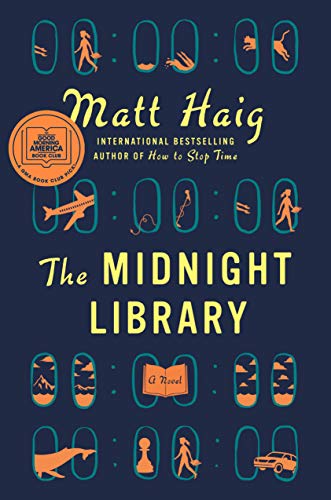
The first book I read by Matt Haig was The Dead Fathers’ Club (2007), which convinced me (and not just because the title was correctly apostrophized) to read everything else he would ever write. When How to Stop Time (2018) disappointed (despite being “award-winning”), I was very happy to see another Haig book appear so quickly; The Midnight Library came out this year and is currently on several bestseller lists. I just finished it, and came up with several reasons to appreciate his genius all over again. Here are my top four.
First
There’s the improbability and originality of the book’s premise. Nora Seed, a 35 year old, decides her crappy life is not living. But when she overdoses, instead of ending up dead (as expected) she finds herself in the midnight library; a strange halfway house between life and death. Inside, she finds “aisles and aisles of shelves, reaching up to the ceiling and branching off from the broad open corridor Nora was walking down. She turned down one of the aisles and stopped to gaze in bafflement at the seemingly endless amount of books.”
All the book covers were various shades of green, with no titles or authors on their spines, making it even harder than a regular library to choose between them. Fortunately, she finds a guide: Mrs. Elm, her childhood librarian, appears, explaining that Nora has been given the chance (before death comes for her) to experience all of the lives she regrets not living. Best of all, Mrs. Elm promises that if she finds a life she really, really likes, she’ll get to stay in it. And until then, time will be stuck at midnight.
Think about that for a minute: the chance to casually dip a toe into what could’ve been, without fear of “wasting” time! Who’s in?
Second
The second reason I so appreciate Haig’s genius is that he keeps this unlikely and fantastical story quite grounded. The Midnight Library reminds us of an actual library, and all of Nora’s other lives are totally believable—just different. He doesn’t focus on the pesky mechanics of time/life travel, because it would just get in the way of the lessons about choice and happenstance that we pick up along the way.
Third
Anyone who remembers the magic powers of a childhood librarian will understand that Mrs. Elm is the perfect guide for exploring a purgatory of regret, nineteen years later. We are first introduced to her in a quick prologue, when Nora finds it hard “not to compare Mrs. Elm to her mother, who treated Nora like a mistake in need of correction.” (So much character backstory, all in that one sentence.) Through the careful repetition of details (short grey hair, a turtle-green polo neck jumper) we recognize the librarian almost before Nora does, when she reappears in the Midnight Library to play tour guide.
Fourth
The language and word choices are magnificent, and each word does the work of several. Consider this world-building passage, when Mrs. Elm first introduces Nora to the library:
As she spoke, Mrs. Elm’s eyes came alive, twinkling like puddles in moonlight.
“Between life and death there is a library,” she said. “And within that library, the shelves go on for ever. Every book provides a chance to try another life you could have lived. To see how things would be different if you had made other choices… would you have done anything different, if you had the chance to undo your regrets?”
And so begins Nora’s chance to experience the lives she would’ve had, if she’d fulfilled one of her many early promises: Olympic swimmer. Glaciologist. Pop star. All of which eventually make her realize that her “root” life was where she belongs after all; she just needs to refocus her gaze on what she can do, not what she hasn’t done. As Mrs. Elm repeats throughout the story, “The only way to learn is to live.”
I’m more conscious of novel structure than I used to be, which may be why the series of losses that initially drives Nora to that suicide attempt seemed a bit heavy-handed. My other quibble is with the climax, which was narrated with more distance than the scene’s intensity warranted. Knowing Haig, this was a conscious choice; perhaps that’s part of Nora Seed learning to come out of her shell and live.
This book is strongly recommended for anyone who would jump at their own chance to explore a few roads not taken. It will be each reader’s choice whether to read it just for the story, or go a little deeper—and consider what really makes life worth living.